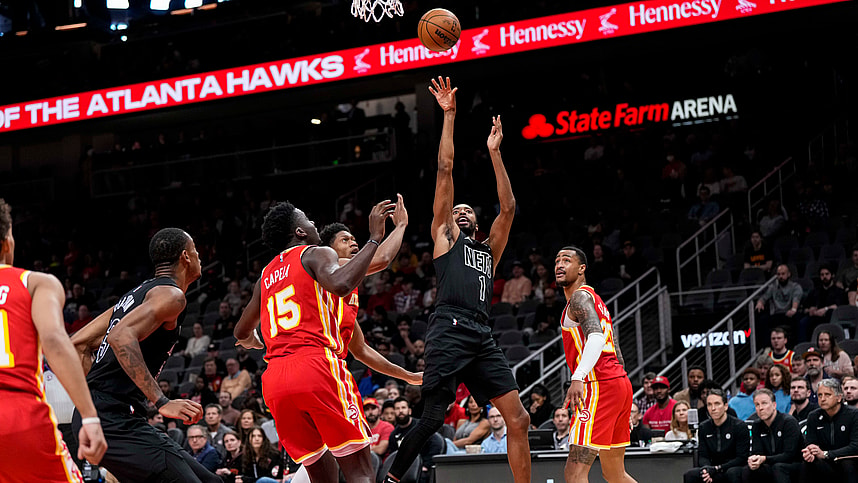
Mikal Bridges continues to bridge the Kevin Durant era to a new one in Brooklyn with an eerily familiar play.
Bridges made his best Durant impression Sunday night in leading the Nets 102-86 rout of the Charlotte Hornets in front of a soldout Barclays Center crowd.
Bridges dropped a career-high 19 points in the opening quarter on a perfect 9 for 9 shooting from the floor. He finished with 33 points on a highly efficient 12 of 21 shooting for his first back-to-back 30-point games in his career and fourth in nine games since getting traded to the Nets.
The feat itself is impressive. But the manner he operated to get there is more impressive.
Bridges picked his spots with various midrange pull-ups, drawing comparisons to the Nets’ former superstar whose big shoes he’s trying to fill.
Durant is a midrange god.
In 39 games with the Nets this season, Durant averaged eight midrange pull-up attempts per game and hit at a 59.6 percent rate. Over half of his shot diet (55.1 percent) came from pull-ups.
“If you work on it enough and you’re confident enough, those can be your layups.”
Mikal Bridges on midrange shots
Since the trade, there’s been an uptick in the frequency of Bridges’ midrange pull-ups from 29.1 to 37.7 percent.
His pull-up game now dominates his shot profile in Brooklyn with 45 percent frequency, while his drives (29.8 percent frequency) and catch-and-shoot (25.2 percent frequency) split the difference.
Before the trade, his shot diet was almost evenly spread: 35.2 percent frequency in catch and shoot, 33 percent in pull-ups, and 31.5 percent in less than 10 feet.
“I know the analytics with the threes and layups, but we’re basketball players at the same time, we work on our games,” Bridges said. “Sometimes you can’t get to the rim, you just can’t. There’s a lot of other space on the floor that you can get to. And if you work on it enough and you’re confident enough, those can be your layups.”
But if you ask Nets coach Jacque Vaughn, he’d prefer Bridges to shoot more 3s and drive more for layups.
“We’ll keep looking at the percentages,” Vaugn said. “What we do want is him to continue to get to the rim and shoot threes for us.”
“He has shown a knack, though, for getting to his spots. We saw it in Boston,” Vaughn said. “So, I’m learning more about him, what shots he likes to get to, and if they’re going in, we love them, but we do want to have a profile of really getting to the rim and shooting threes and putting pressure on the defense that way also.”
Bridges’ shooting percentages from the midrange give credence to his belief that the worst shot in the analytics era could be his layups.
In 56 games with the Suns this season, Bridges averaged four attempts from midrange pull-ups and hit it at a 44.1 percent clip. With the Nets, Bridges is putting up more with 6.3 attempts and shooting better (50.9 percent clip). While it’s still not on Durant’s level, it’s the best Nets can have after the superstar’s departure.
Zooming in, Bridges is almost automatic on mid-range shots off two dribbles, hitting 13 of 18 for 72.7 percent. His shooting percentage goes down with three to six dribbles, but he is still sinking a solid 55.8 percent (24 out of 43 pull-ups).
After all, Bridges have learned from the best midrange shooters — not named Durant, Kawhi Leonard, and DeMar DeRozan — Chris Paul and Devin Booker in Phoenix. Together they have consistently made the Suns one of the five best mid-range teams in the NBA in the past three seasons.
Bridges have brought that along to Brooklyn with a higher frequency that came with the dramatic shift in his minutes and role.
Despite being discouraged in the era of analytics, the midrange shot remains a powerful tool in the playoffs when the game slows down and opposing teams double down on taking away paint scoring and the three-point shot.
Durant has mastered it. Bridges is getting there.
All he needs is the license to keep on shooting from midrange.
Follow this writer on Twitter: @alderalmo
More about: Brooklyn Nets